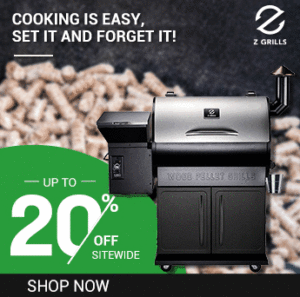So, you’ve been barbecuing on charcoal and gas grills, but what is that people keep telling you about pellet grills? What the heck are pellets? How do they work? Most importantly, what is the best pellet grill options to invest in? If you’re too embarrassed to ask people about it, we’re here to help.
What Is a Pellet Grill?
It’s an electric outdoor grill powered by hardwood pellets. Imagine a side-mounter hopper in place of a firebox in a traditional offset barrel smoker. It is fueled with cylindrical food-grade wood pellets – about ¼-inch wide and an inch long – consisting of compressed sawdust (hardwood). The sawdust is placed under high heat and pressure, which activates a natural glue inside it called lignin. Pellets don’t have any additives apart from the vegetable oil used to carry flavor or aid the process of extrusion. They burn clean, leaving incredibly minimum ash.
How Do Pellet Grills Work?
They’re essentially an outdoor cooker that requires electricity to run. When they’re plugged in, and the digital controller is activated, a rotating auger performs the job of delivering pellets to a cylindrical fire pot that houses an igniter rod directly from the hopper. For a reasonable amount of time, the rod glows hot to ignite the pellets. Combusting pellets then produce smoke and heat which are diffused by a blowing fan as well as the grill grate’s metal plates.
Most pellet grills burn wood pellets as fuel to flavor, smoke, and cook all types of proteins and meats. They also have the capability to accommodate larger quantities of food and span larger in size than usual household appliances.
Advantages & Disadvantages of Pellet Grills
Advantages:
They preheat quick. Just like gas grills, only the preheating process requires 10-15 minutes at maximum.
Some models of pellet grills give users pinpoint heating control by enabling them to regulate temperature in increments of 5-degrees. That is done with the help of a thermostat that sends accurate signals from the cooking chamber to the control as well as plays the role of a pellet delivery regulator.
The grill is versatile. It can roast, grill, smoke, barbecue, and even braise or bake a variety of foods. Examples include braising short ribs to barbecuing crisp chicken wings.
It’s hard to over-cook things on a pellet grill. Also, compared to the acrid smoke produced by charcoal fire or straight wood, the smoke flavor generated by a pellet grill is subtler.
As the functioning of a pellet grill is similar to the functioning of a convection oven, the user can load up cook chambers without stressing over uneven cooking. Also, soaked wood chips can be kept on the head diffuser plate directly in pouches.
Shortcomings
They have limited portability because of their reliance on electricity. In case of a power outage, the user needs to have access to an inverter or generator.
Though they’re known as “grills,” they don’t produce dark sears or grill marks, as fan-driven heat is used to run them. Hence, they’re often referred to as smokers. That said, the quantity of caramelization on the outside of cooked food can be increased with the use of a cast iron grill grate.
Less smoke will be generated at high cooking temperatures. Most smoke flavors come below 250 degrees’ temperature.
Any sort of grill that features electrical components or moving parts are prone to break down, a shortcoming that’s not present in wood or charcoal grills. Pellet fuels can disintegrate when exposed to moisture, so it’s important for those residing in humid climates to keep their pellet smokers in a dry place.
What Makes a Good Pellet Grill?
It doesn’t matter if you’re gearing up to grill beef, salmon, or chicken, you have to pick the right pellet grill for the job. While the answer depends on your needs, and your preferences, it helps to gain knowledge of the factors that make up the best pellet grill. Below are some of the important elements that go into the buying decision.
Temperature Controller: The ability of a pellet grill is largely based on its control board, which is the central nervous system of the grill. Different types of controllers including ones that feature an LCD and one-touch button allow users to produce great food. Ideally, the control should offer temperature control between 180 Fahrenheit 425 Fahrenheit.
Cooking Area & Size: Small pellet grills usually feature 450 sq. inch of primary cooking area and 100-150 sq. feet of the upper rack. It isn’t much different from larger variants that feature 500-700 sq. inch of primary cooking area. For larger families, a primary surface of 350-800 sq. inches should be enough.
Construction: The best pellet grills are made from painted steel. They’re painted using a high-quality powder coat that can survive high heat without going pale. The body should be painted well, as the steel can easily rust once exposed.
